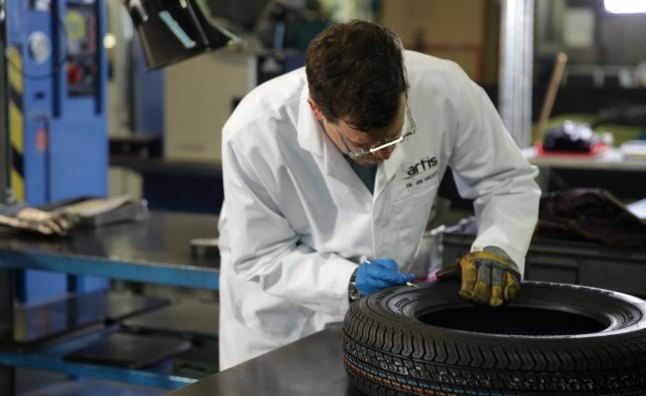Color Changing Tires Warn of Winter Weather

Winter-tire technology is advancing at a rapid rate. Today’s winter rubber is so superior to snow tires of yesteryear that the two can’t even be compared. This is great news for those who live in regions with nasty winter weather as more and more passenger vehicles are rolling off of showroom floors with summer tires or low rolling-resistance tires, neither of which are well suited to handle the white stuff.
But when is the correct time to switch from summer or all-season tires to winter ones? A big misconception is that winter tires are for snow only. In reality they’re really for cold temperatures. Tires are elastic by nature and mold to the road surface to provide optimal grip. But when a tire gets cold enough it stiffens up, behaving more like slippery plastic than rubber; below the freezing mark summer tires become as hard as a brick wall…. made from hydrocarbons. There doesn’t have to be snow or ice on the road for a non-winter tire to become dangerously slick.
So back to the question at hand – when should you change over to winter tires? Well, most all-season rubber begins to lose its adhesion at temperatures below 45 degrees Fahrenheit. But what if you’re not paying attention to the outdoor thermometer everyday? A Canadian company thinks it has the answer.
As Canada’s largest retail distributor of winter tires, Canadian Tire contracted Dr. Joe Hallett of the rubber research and development organization ARTIS to create a concept tire that would warn consumers when temperatures dipped below a tire’s operating range. The idea he came up couldn’t be simpler for everyday consumers to comprehend: have the tires change color based on how warm or cold they are.
But for modern motorists giant white bands around the sidewalls of their tires are a bit ugly. Chances are most consumers would NOT want them, but Canadian Tire has other ideas on how to integrate this technology into tires. One way is by making the tire’s branding change color, or perhaps have the words “all-season” change hue. Additionally, that thermochromic pigment is customizable. The tire we saw is designed to change at 45 degrees, but that temperature can be customized to any number depending on the tire.
Sadly this concept technology is just that at the moment – a concept. Issues like sun-fade and tire wear need to be worked out, to say nothing of durability and longevity.
Hopefully these challenges will be surmounted in the not-too-distant future. This technology promises to make life a little easier for people that live cold-weather places or in municipalities that mandate winter tires.

A 20+ year industry veteran, Mike rejoins the AutoGuide team as the Managing Editor. He started his career at a young age working at dealerships, car rentals, and used car advertisers. He then found his true passion, automotive writing. After contributing to multiple websites for several years, he spent the next six years working at the head office of an automotive OEM, before returning back to the field he loves. He is a member of the Automobile Journalists Association of Canada (AJAC), and Midwest Automotive Media Association (MAMA). He's the recipient of a feature writing of the year award and multiple video of the year awards.
More by Mike Schlee


































Comments
Join the conversation